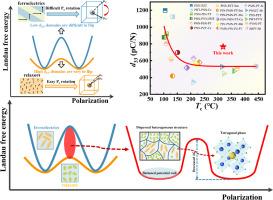A novel strategy for obtaining lead-based piezoelectric ceramics with giant piezoelectricity and high-temperature stability through the construction of “slush-like” polar states
IF 11.2
1区 材料科学
Q1 MATERIALS SCIENCE, MULTIDISCIPLINARY
引用次数: 0
Abstract
Maintaining high piezoelectric response and piezoelectric temperature stability of lead-based piezoceramics is critical for applications under high-temperature environments. Unfortunately, the piezoelectric response of lead-based piezoceramics shows strong temperature dependence. Herein, an innovative strategy was proposed to solve this problem. The method consisted of constructing “slush-like” polar states by introducing localized heterostructures in the tetragonal phase structure to lower the energy barriers. The presence of the tetragonal phase stabilized the domain structure, providing excellent temperature stability, while the localized heterostructures also flattened the free energy landscape and enhanced the piezoelectric response. The strategy was implemented by using 0.11Pb(In0.5Nb0.5)O3-0.89Pb(Hf0.47Ti0.53)O3(PIN-PHT) piezoceramics doped with heterovalent ion Nb5+ to form a “slush-like” polar state with strong interactions inside the ceramics. The piezoelectric response and relaxor behavior of the ceramics were then investigated using piezoelectric force microscopy to reveal the mapping relationship between the complex ferroelectric domain structure and both the piezoelectric response and temperature stability. At Nb5+ doping amount of 0.8 mol%, the ceramics showed excellent comprehensive performances with d33 = 764 pC/N, Tc = 319.1 °C, = 3253.59, kp = 0.67, and tanδ = 0.0122. At an external ambient temperature of 300°C, the d33 of PIN-PHT-0.8Nb5+ remained high at 734 pC/N, with piezoelectric performance retention of 96.1%, showing excellent temperature stability. Overall, a new path was proposed for developing Pb-based piezoceramics with both good piezoelectric response and high-temperature stability, promising to broaden the temperature range of high-temperature piezoceramics for various applications.

通过构建 "泥浆状 "极性态获得具有巨压电性和高温稳定性的铅基压电陶瓷的新策略
保持铅基压电陶瓷的高压电响应和压电温度稳定性对于高温环境下的应用至关重要。遗憾的是,铅基压电陶瓷的压电响应具有很强的温度依赖性。为此,我们提出了一种创新策略来解决这一问题。该方法包括通过在四方相结构中引入局部异质结构来构建 "泞状 "极态,从而降低能垒。四方相的存在稳定了畴结构,提供了出色的温度稳定性,同时局部异质结构还使自由能分布更加平坦,增强了压电响应。该策略通过使用掺杂异价离子 Nb5+ 的 0.11Pb(In0.5Nb0.5)O3-0.89Pb(Hf0.47Ti0.53)O3(PIN-PHT) 压电陶瓷来实现,从而在陶瓷内部形成具有强相互作用的 "泞状 "极性状态。然后利用压电显微镜研究了陶瓷的压电响应和弛豫行为,揭示了复杂铁电畴结构与压电响应和温度稳定性之间的映射关系。当 Nb5+ 掺杂量为 0.8 mol% 时,陶瓷显示出优异的综合性能,d33 = 764 pC/N,Tc = 319.1 °C,εr = 3253.59,kp = 0.67,tanδ = 0.0122。在外部环境温度为 300°C 时,PIN-PHT-0.8Nb5+ 的 d33 仍保持在 734 pC/N 的高水平,压电性能保持率为 96.1%,显示出优异的温度稳定性。总之,这为开发具有良好压电响应和高温稳定性的铅基压电陶瓷提出了一条新的途径,有望拓宽高温压电陶瓷的温度范围,使其应用于各种领域。
本文章由计算机程序翻译,如有差异,请以英文原文为准。
求助全文
约1分钟内获得全文
求助全文
来源期刊

Journal of Materials Science & Technology
工程技术-材料科学:综合
CiteScore
20.00
自引率
11.00%
发文量
995
审稿时长
13 days
期刊介绍:
Journal of Materials Science & Technology strives to promote global collaboration in the field of materials science and technology. It primarily publishes original research papers, invited review articles, letters, research notes, and summaries of scientific achievements. The journal covers a wide range of materials science and technology topics, including metallic materials, inorganic nonmetallic materials, and composite materials.
 求助内容:
求助内容: 应助结果提醒方式:
应助结果提醒方式:


